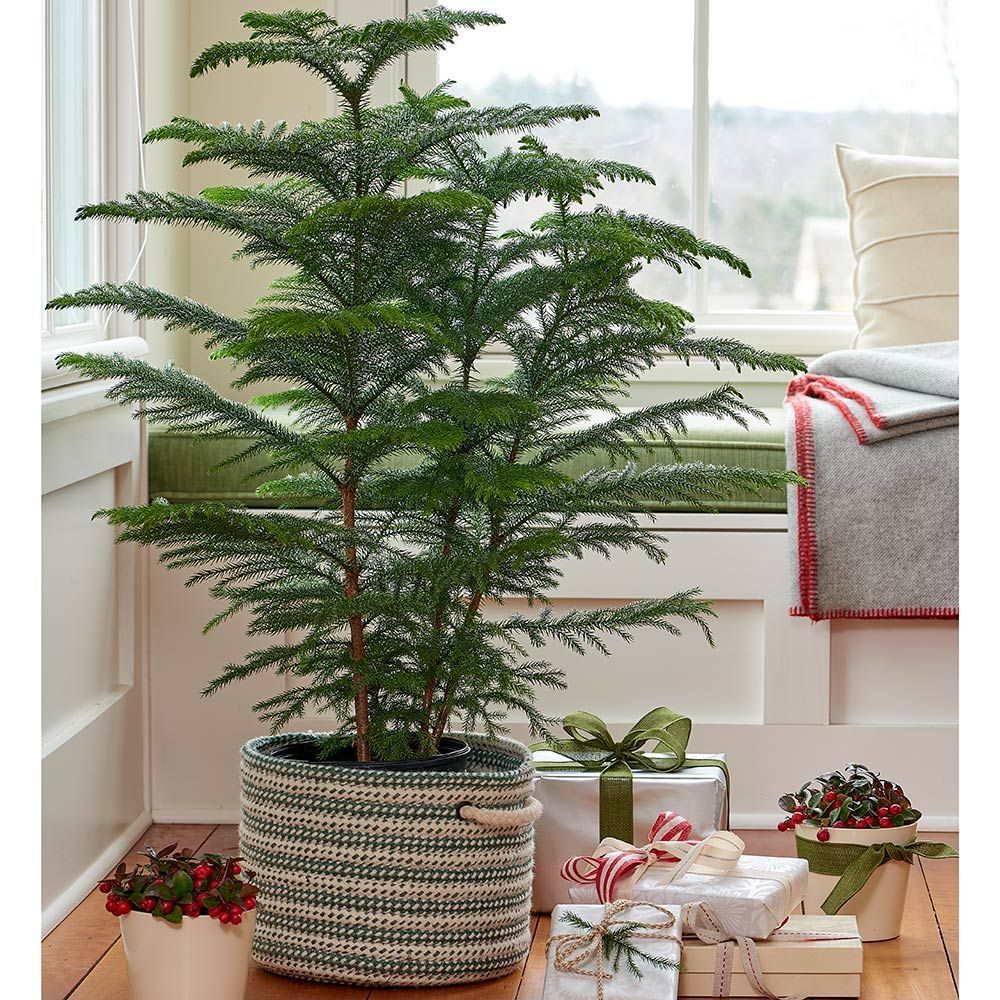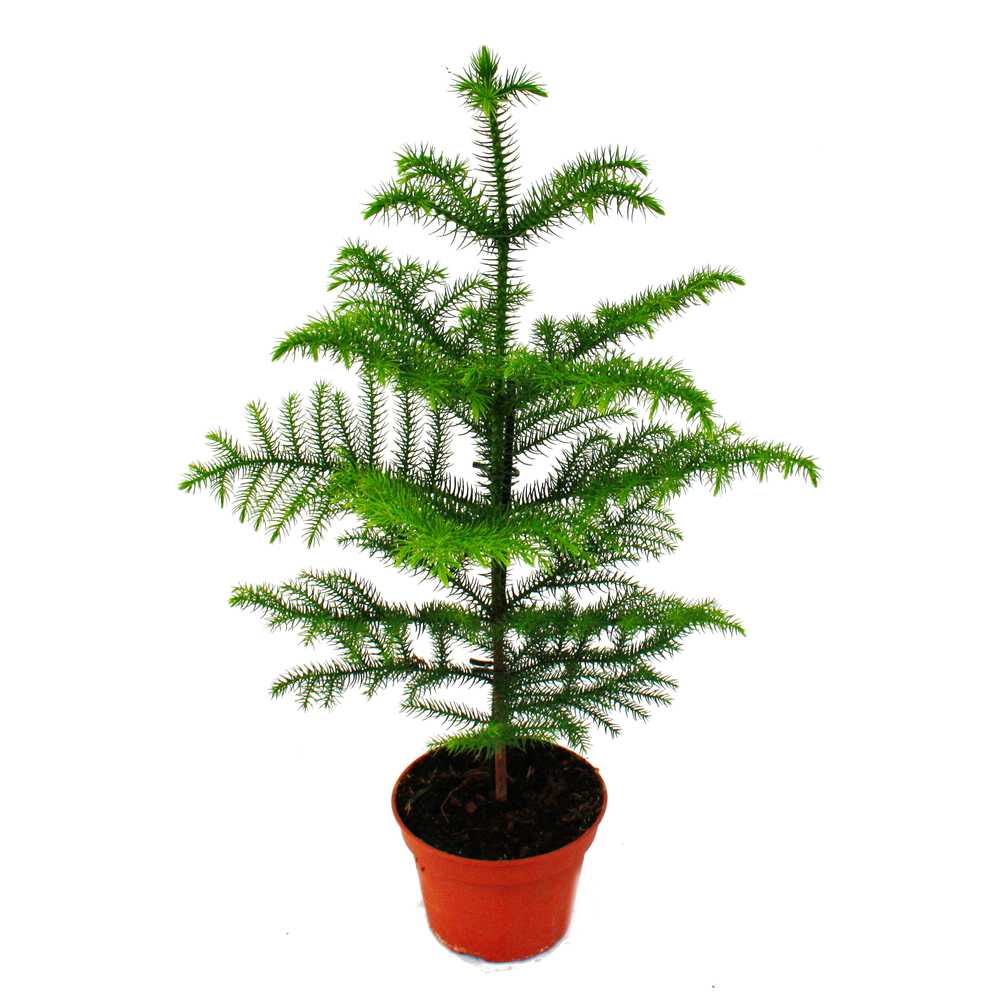Understanding Your Norfolk Island Pine
Norfolk Island Pine, scientifically known as Araucaria heterophylla, is a majestic houseplant that brings a touch of the South Pacific into your home. Often mistaken for a true pine, this tropical plant, native to Norfolk Island in the Pacific Ocean, is a popular choice for its symmetrical beauty and adaptability as an indoor plant. 🌿🏝️

Not Your Average Pine
The Norfolk Island Pine, despite its name, is not a true pine. This evergreen’s lush green, needle-like foliage, and symmetrical branches have made it a favorite, especially around the holidays, often doubling as a living Christmas tree.
Tropical Origins
Hailing from Norfolk Island, located in the Pacific Ocean between New Zealand and New Caledonia, this tree is a tropical plant that thrives in warm, humid conditions. Understanding its native habitat is crucial to replicating the ideal home environment. 🌊🌴
Caring for Your Norfolk Island Pine: The Basics
Light and Location
Proper light is essential for the health of your Norfolk Pine. It thrives in bright indirect light, so placing it near a south-facing window where it can receive several hours of direct sun is ideal. Remember, inadequate light can lead to leggy, sparse growth.
Watering Requirements
Water requirements for Norfolk Island Pine can vary based on the light and temperature. The general rule is to water when the top inch of soil feels dry. Expect to water more often in brighter light and less often in lower light conditions. 💧🌱
Humidity and Temperature
Being a tropical plant native to the South Pacific, Norfolk Island Pines prefer a humid environment. Indoor humidity levels can be increased with a humidifier or a pebble tray. These trees can tolerate temperatures below 35 degrees Fahrenheit but thrive in warmer conditions.
Potting and Soil
When potting your plant, use a well-draining potting mix. Ensure the pot has drainage holes to prevent water from sitting at the bottom, which can lead to root rot. As the tree grows, repotting may be necessary every few years to accommodate its size. 🪴🌲
Fertilizing
During the growing season (spring and summer), fertilize your Norfolk Pine with a balanced liquid fertilizer. This will encourage healthy growth and maintain its vibrant green color. In the winter, reduce feeding as the plant’s growth slows down.
Pruning and Maintenance
Pruning is not typically necessary for Norfolk Island Pines, as they naturally maintain a symmetrical shape. However, removing dead or yellowing branches can keep your tree looking neat and healthy.
Growing Norfolk Island Pine Indoors and Outdoors
Indoor Care
When grown indoors, Norfolk Island Pine can become a striking addition to your home. Its care involves balancing the right amount of light, water, and humidity. Placing your plant in a room with enough light and maintaining consistent watering will ensure its thriving presence indoors.
Outdoor Growth
In warmer climates, you can move your Norfolk Island Pine outdoors to a shaded area during the warmer months. However, this tree cannot tolerate cold temperatures and should be brought inside when the temperature drops.
Potential Challenges and Solutions
Common Problems
- Brown Tips: Caused by low humidity or infrequent watering.
- Drooping Branches: Often a sign of either overwatering or underwatering.
- Pest Issues: Keep an eye out for scale insects and spider mites.
Solutions
- Increase Humidity: Use a humidifier or pebble tray.
- Adjust Watering: Ensure consistent watering based on the dryness of the soil.
- Regular Checks: Inspect your tree regularly for signs of pests or diseases.
Norfolk Island Pine as a Decorative Element
A Festive Touch
During the holiday season, the Norfolk Island Pine shines as a live Christmas tree. Decorate it with lightweight ornaments to add a festive touch without damaging its delicate branches.
Year-Round Elegance
Even beyond the holidays, this tree adds a refined, natural element to any room. Its soft, green needles and upright growth make it a beautiful and lively addition to your home decor.
Propagation and Long-Term Care
Propagating
Propagation of Araucaria heterophylla is typically done through seeds, as they do not propagate easily from cuttings. This process requires patience and care, as growth from seed can be slow.
Long-Term Plant Care
With proper care, your Norfolk Island Pine can grow into a magnificent indoor tree, reaching several feet in height. Be prepared to adjust your care routine as the tree matures, providing it with a larger pot and more water as it grows.
In conclusion, the Norfolk Island Pine is a fascinating and rewarding plant to grow. Its care might be a bit more involved than your average houseplant, but the result is a stunning, tree-like presence in your home. Whether you’re using it as a holiday centerpiece or as a year-round green companion, the Araucaria heterophylla is sure to bring joy and a touch of the tropics into your living space. 🌲🏠

FAQ
1. What is a Norfolk Island Pine Tree?
The Norfolk Island Pine Tree, or Araucaria heterophylla, often simply called Norfolk, is a tropical plant native to Norfolk Island in the Pacific Ocean. Despite its common name, it’s not a true pine but a coniferous tree known for its symmetrical, tiered branches and lush, evergreen foliage.
2. How Do I Care for My Norfolk Island Pine?
Caring for a Araucaria heterophylla involves a few key steps:
- Sunlight: Ensure your plant gets plenty of bright, indirect light. It thrives in sunny spots but can burn in harsh, direct sun.
- Watering: Water your Norfolk when the surface of the soil feels dry. Overwatering can lead to root rot, so ensure the pot has good drainage.
- Humidity: As a tropical plant, it enjoys higher humidity levels. Consider using a humidifier or placing it on a pebble tray.
- Temperature: Keep it in a warm spot, away from cold drafts. 🌞💧🌡️
3. Can I Grow Norfolk Island Pine Outside?
Yes, Norfolk Pine can be grown outdoors in warmer climates. If you live in a region with mild winters, you can move it outdoors in summer. However, it’s sensitive to cold and should not be left outside in freezing temperatures.
4. What Are the Lighting Needs for Pine?
Norfolk Island Pine needs sun but prefers bright, indirect light. Placing it near a south-facing window is ideal. If your home doesn’t get enough natural light, consider using grow lights to supplement. 🌤️💡
5. How Often Should I Water My Norfolk Island Pine?
Water your houseplant when the top inch of the soil feels dry. Reduce watering in the winter when the plant’s growth slows down. It’s essential to let the soil dry out between waterings to prevent overwatering.
6. Do I Need to Fertilize My Pine?
Yes, feed your Norfolk during the growing season (spring and summer) with a balanced liquid fertilizer. This will promote healthy growth. In the winter, cease fertilization as the plant enters a dormant phase. 🌱🍽️
7. Can I Use Norfolk Pine as a Holiday Tree?
Absolutely! The Norfolk Island Pine’s symmetrical growth and evergreen appearance make it a popular choice as a living holiday tree. Decorate it with lightweight ornaments to prevent damage to its delicate branches. 🎄🎉
8. How Big Can a Norfolk Island Pine Grow Indoors?
Indoors, this plant can grow quite tall, often reaching several feet in height. Regular pruning can help manage its size, but it naturally grows into a tall, elegant tree.
9. What Should I Do If My Norfolk Island Pine Starts Losing Lower Branches?
It’s natural for older Norfolk Island Pines to shed their lower branches as they grow. If your tree is losing branches, make sure it’s receiving enough light and isn’t overwatered. Adjust your care routine as needed.
10. How Do I Repot a Araucaria heterophylla?
Repot your plant when it becomes root-bound or outgrows its current pot. Choose a pot slightly larger than the current one and use a well-draining potting mix. Be gentle during repotting to avoid damaging the roots. 🪴➡️🌳
11. Can Norfolk Island Pine Be Propagated?
Propagating Araucaria heterophylla is challenging and usually done through seeds. It’s not typically propagated from cuttings, as they rarely take root.
12. Are There Different Varieties of Norfolk Island Pine?
While there are various species within the Araucaria genus, the commonly grown houseplant is usually the classic Norfolk Island Pine. Each has similar care requirements but may vary slightly in appearance.
13. How Do I Deal with Pests on My Norfolk Pine?
Inspect your Norfolk Pine regularly for signs of pests like spider mites. If pests are found, treat them with an appropriate insecticide and isolate the plant to prevent spread to other houseplants.
14. Is Norfolk Island Pine Safe for Pets?
Araucaria heterophylla is generally considered non-toxic to pets, but it’s always best to keep an eye on your furry friends and prevent them from chewing on any houseplants. 🐾🌿

